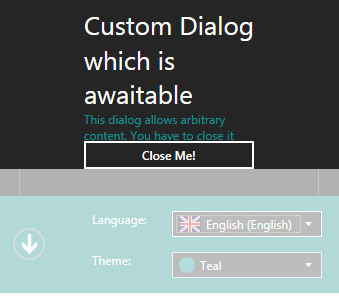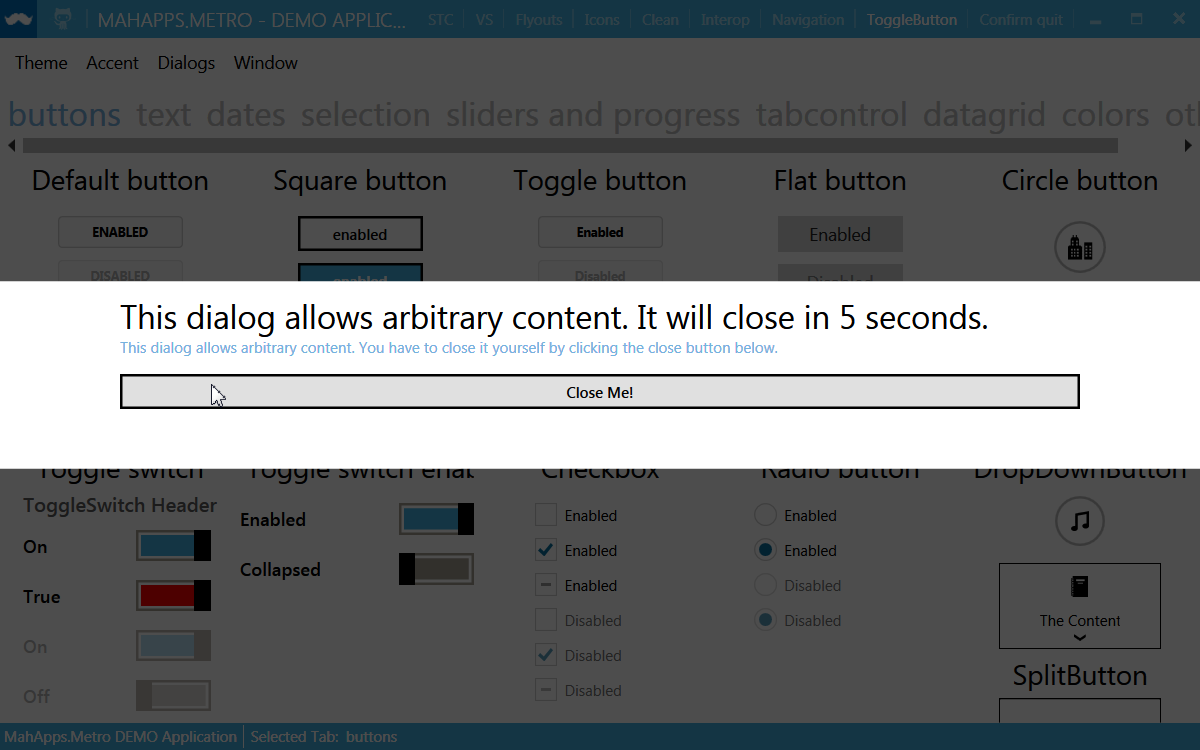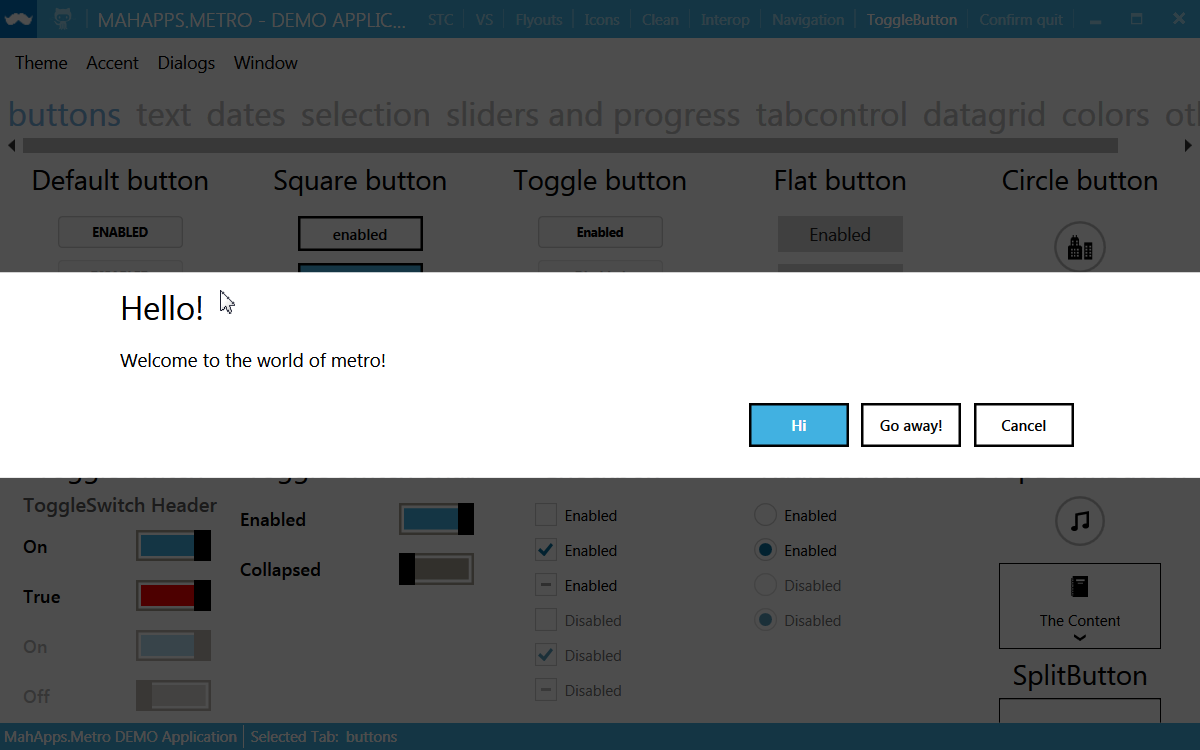Как изменить MahApps.Ширина шаблона содержимого диалога Metro?
Я хотел бы изменить базовый шаблон MahApps.Метро!--4--> диалоги (или создать новый тип диалога), потому что я хотел бы показать их в узком окне входа в систему. Прямо сейчас почти все вторые слова в сообщении находятся в новой строке, но есть хорошие большие пробелы справа и слева, которые я хотел бы уменьшить.

Я нашел в BaseMetroDialog.xaml что окно сообщений разделено на три части по вертикали: 25% место на левой стороне, 50% для содержания и 25% пробел с правой стороны. Я хотел бы изменить эти цифры.
но как я могу изменить шаблон контроля BaseMetroWindow мой новый?
4 ответов
просто создайте свой собственный стиль, который перекрывает диалоговое окно Template (и добавить DialogShownStoryboard тоже).
<Style TargetType="{x:Type Dialog:BaseMetroDialog}"
x:Key="NewCustomDialogStyle"
BasedOn="{StaticResource {x:Type Dialog:BaseMetroDialog}}">
<Setter Property="Template">
<Setter.Value>
<ControlTemplate TargetType="{x:Type Dialog:BaseMetroDialog}">
<ControlTemplate.Resources>
<Storyboard x:Key="DialogShownStoryboard">
<DoubleAnimation AccelerationRatio=".9"
BeginTime="0:0:0"
Duration="0:0:0.2"
Storyboard.TargetProperty="Opacity"
To="1" />
</Storyboard>
</ControlTemplate.Resources>
<Grid Background="{TemplateBinding Background}">
<Border FocusVisualStyle="{x:Null}"
Focusable="False">
<Grid>
<Grid.RowDefinitions>
<RowDefinition Height="Auto" />
<RowDefinition Height="*" />
<RowDefinition Height="Auto" />
</Grid.RowDefinitions>
<ContentPresenter Grid.Row="0"
Content="{TemplateBinding DialogTop}" />
<Grid Grid.Row="1">
<Grid.ColumnDefinitions>
<ColumnDefinition Width="10*" />
<ColumnDefinition Width="80*" />
<ColumnDefinition Width="10*" />
</Grid.ColumnDefinitions>
<!-- Content area -->
<Grid Grid.Column="1"
Margin="0 10 0 0">
<Grid.RowDefinitions>
<RowDefinition Height="Auto" />
<RowDefinition Height="*" />
</Grid.RowDefinitions>
<TextBlock Grid.Row="0"
FontSize="{DynamicResource DialogTitleFontSize}"
Foreground="{TemplateBinding Foreground}"
Text="{TemplateBinding Title}"
TextWrapping="Wrap" />
<ContentPresenter Grid.Row="1"
Content="{TemplateBinding Content}" />
</Grid>
</Grid>
<ContentPresenter Grid.Row="2"
Content="{TemplateBinding DialogBottom}" />
</Grid>
</Border>
</Grid>
<ControlTemplate.Triggers>
<EventTrigger RoutedEvent="Loaded">
<EventTrigger.Actions>
<BeginStoryboard Storyboard="{StaticResource DialogShownStoryboard}" />
</EventTrigger.Actions>
</EventTrigger>
</ControlTemplate.Triggers>
</ControlTemplate>
</Setter.Value>
</Setter>
</Style>
пространство имен здесь
xmlns:Dialog="clr-namespace:MahApps.Metro.Controls.Dialogs;assembly=MahApps.Metro"
теперь используйте этот пользовательский стиль, например, для пользовательского диалога
<Dialog:CustomDialog x:Key="CustomDialogTest"
Style="{StaticResource NewCustomDialogStyle}"
Title="This dialog allows arbitrary content. It will close in 5 seconds."
x:Name="CustomTestDialog">
<StackPanel>
<TextBlock Height="30"
Text="This dialog allows arbitrary content. You have to close it yourself by clicking the close button below."
TextWrapping="Wrap"
Foreground="{DynamicResource AccentColorBrush}" />
<Button Content="Close Me!" />
</StackPanel>
</Dialog:CustomDialog>
скриншот из основной демо

обновление
С последней версией MahApps.Метро теперь можно изменить, например,MessageDialog стиль глобально.
<Style TargetType="{x:Type Dialog:MessageDialog}"
x:Key="NewCustomMessageDialogStyle"
BasedOn="{StaticResource {x:Type Dialog:BaseMetroDialog}}">
<Setter Property="Template">
<!-- the custom template for e.g. MessageDialog -->
</Setter>
</Style>
<Style TargetType="{x:Type Dialog:MessageDialog}" BasedOn="{StaticResource NewCustomMessageDialogStyle}" />

надеюсь, что это поможет!
мне потребовалось некоторое время, чтобы разобраться в этом, но для таких новичков, как я, вот мое полностью документированное решение для создания настраиваемых диалоговых окон с помощью mahapps и MVVM. Вероятно, есть аспекты, которые можно было бы улучшить, но это то, что сработало для меня.
объявите свой словарь ресурсов диалогового окна в приложении.xaml, поэтому он доступен глобально
App.в XAML
<Application x:Class="MyAppName.App"
xmlns="http://schemas.microsoft.com/winfx/2006/xaml/presentation"
xmlns:x="http://schemas.microsoft.com/winfx/2006/xaml"
xmlns:local="clr-namespace:MyAppName"
xmlns:Controls="clr-namespace:MahApps.Metro.Controls;assembly=MahApps.Metro"
xmlns:Dialog="clr-namespace:MahApps.Metro.Controls.Dialogs;assembly=MahApps.Metro"
>
<Application.Resources>
<ResourceDictionary>
<ResourceDictionary.MergedDictionaries>
<ResourceDictionary>
<ResourceDictionary Source="DialogResource.xaml" />
</ResourceDictionary.MergedDictionaries>
</ResourceDictionary>
</Application.Resources>
</Application>
словарь ресурсов содержит код замены шаблона для пользовательского диалоговое окно
DialogResource.в XAML
<ResourceDictionary xmlns="http://schemas.microsoft.com/winfx/2006/xaml/presentation"
xmlns:x="http://schemas.microsoft.com/winfx/2006/xaml"
xmlns:local="clr-namespace:MyAppName.MyResources"
xmlns:Controls="clr-namespace:MahApps.Metro.Controls;assembly=MahApps.Metro"
xmlns:Dialog="clr-namespace:MahApps.Metro.Controls.Dialogs;assembly=MahApps.Metro"
>
<!== Override default template for Mahapps custom dialog -->
<Style TargetType="{x:Type Dialog:BaseMetroDialog}"
x:Key="NewCustomDialogStyle"
BasedOn="{StaticResource {x:Type Dialog:BaseMetroDialog}}">
<Setter Property="Template">
<!-- Custom template xaml code goes here -- see above StackOverflow answer from Punker76 --->
</Setter>
</Style>
</ResourceDictionary>
создайте окно WPF с именем UserInputDialog затем замените все код xaml с помощью customdialog xaml. Im использует синтаксис Caliburn Micro для привязки кнопок к диалоговому окну подложки viewmodel (cal:Message.Придавать.)= В случае диалогового кода xaml мне нужно вручную указать привязки кнопок, так как по какой-то причине с Caliburn Micro он не является автоматическим, как в главном представлении модель.
UserInputDialog.в XAML
<Dialog:CustomDialog
x:Name="MyUserInputDialog"
x:Class="MyAppName.UserInputDialog"
Style="{StaticResource NewCustomDialogStyle}"
xmlns="http://schemas.microsoft.com/winfx/2006/xaml/presentation"
xmlns:x="http://schemas.microsoft.com/winfx/2006/xaml"
xmlns:d="http://schemas.microsoft.com/expression/blend/2008"
xmlns:mc="http://schemas.openxmlformats.org/markup-compatibility/2006"
xmlns:Dialog="clr-namespace:MahApps.Metro.Controls.Dialogs;assembly=MahApps.Metro"
xmlns:Controls="clr-namespace:MahApps.Metro.Controls;assembly=MahApps.Metro"
xmlns:cal="http://www.caliburnproject.org"
xmlns:diag="clr-namespace:System.Diagnostics;assembly=WindowsBase"
>
<!-- , diag:PresentationTraceSources.TraceLevel=High -->
<StackPanel Orientation="Vertical" HorizontalAlignment="Center" VerticalAlignment="Center" >
<Label HorizontalAlignment="Center" Margin="10" Content="{Binding MessageText}" />
<TextBox x:Name="tbInput"
Width="200"
Margin="10"
Content="{Binding UserInput}"
HorizontalAlignment="Center"
KeyDown="tbInput_KeyDown"
/>
<StackPanel Orientation="Horizontal" HorizontalAlignment="Center" Margin="10,20" >
<Button x:Name="butOK"
Content="OK"
Width="80"
Margin="10,0"
HorizontalAlignment="Center"
cal:Message.Attach="butOK"
/>
<Button x:Name="butCancel"
Content="Cancel"
Width="80"
Margin="10,0"
HorizontalAlignment="Center"
cal:Message.Attach="butCancel"
/>
</StackPanel>
</StackPanel>
</Dialog:CustomDialog>
и код-за Для UserInputDialog:
UserInputDialog.код XAML.cs
using MahApps.Metro.Controls.Dialogs;
using System;
using System.Windows;
using System.Windows.Controls;
using System.Windows.Input;
namespace MyAppName
{
public partial class UserInputDialog : CustomDialog
{
public UserInputDialog()
{
InitializeComponent();
MinWidth = 300;
MinHeight = 300;
Loaded += Dialog_Loaded;
}
private void Dialog_Loaded(Object sender, RoutedEventArgs e)
{
tbInput.Focus();
}
private void tbInput_KeyDown(object sender, KeyEventArgs e)
{
//Not strictly MVVM but prefer the simplicity of using code-behind for this
switch (e.Key)
{
case Key.Enter:
if(this.DataContext != null) (dynamic)this.DataContext.butOK();
break;
case Key.Escape:
if(this.DataContext != null) (dynamic)this.DataContext.butCancel();
break;
}
}
}
}
создать класс viewmodel специально для диалога ввода пользователя
UserInputViewModel.cs
using System;
using System.Windows.Input;
using Caliburn.Micro;
using MyAppName.Models;
using System.Security;
namespace MyAppName.ViewModels
{
public class UserInputViewModel : PropertyChangedBase
{
private readonly ICommand _closeCommand;
public string MessageText { get; set; } // Message displayed to user
public string UserInput { get; set; } // User input returned
public bool Cancel { get; set; } // Flagged true if user clicks cancel button
//Constructor
public UserInputViewModel(Action<UserInputViewModel> closeHandler)
{
Cancel = false;
_closeCommand = new SimpleCommand { ExecuteDelegate = o => closeHandler(this) };
}
public void butCancel()
{
Cancel = true;
_closeCommand.Execute(this);
}
public void butOK()
{
Cancel = false;
_closeCommand.Execute(this);
}
//-----------------
}
}
создайте отдельный класс ICommand для передачи во внешнем диалоговом окне функции close с помощью конструктора dialog viewmodel
SimpleCommand.cs
using System;
using System.Windows.Input;
namespace MyAppName.Models
{
public class SimpleCommand : ICommand
{
public Predicate<object> CanExecuteDelegate { get; set; }
public Action<object> ExecuteDelegate { get; set; }
public bool CanExecute(object parameter)
{
if (CanExecuteDelegate != null)
return CanExecuteDelegate(parameter);
return true; // if there is no can execute default to true
}
public event EventHandler CanExecuteChanged
{
add { CommandManager.RequerySuggested += value; }
remove { CommandManager.RequerySuggested -= value; }
}
public void Execute(object parameter)
{
if (ExecuteDelegate != null)
ExecuteDelegate(parameter);
}
}
}
и наконец, вот код модели основного вида для отображения настроенного диалогового окна и обработки возвращенного пользовательского ввода: -
MainViewModel.cs
using MahApps.Metro.Controls.Dialogs;
namespace MyAppName.ViewModels
{
/// <summary>
/// The ViewModel for the application's main window.
/// </summary>
public class MainViewModel : PropertyChangedBase
{
private readonly IDialogCoordinator _dialogCoordinator;
//Constructor
public MainViewModel(IDialogCoordinator dialogCoordinator)
{
// Dialog coordinator provided by Mahapps framework
// Either passed into MainViewModel constructor to conform to MVVM:-
_dialogCoordinator = dialogCoordinator;
// or just initialise directly here
// _dialogCoordinator = new DialogCoordinator();
}
public async void GetUserInput()
{
var custom_dialog = new UserInputDialog();
custom_dialog.Height = 300;
custom_dialog.Width = 400;
var dialog_vm = new UserInputViewModel(async instance =>
{
await _dialogCoordinator.HideMetroDialogAsync(this, custom_dialog);
//instance --> dialog ViewModel
if (!(instance.Cancel || String.IsNullOrEmpty(instance.UserInput)) ProcessUserInput(instance.UserInput);
});
dialog_vm.MessageText = "Please type in your first name";
custom_dialog.DataContext = dialog_vm;
await _dialogCoordinator.ShowMetroDialogAsync(this, custom_dialog);
}
public ProcessUserInput(string input_message){
Console.WriteLine("Users firstname is " + input_message);
}
}
}
переопределить стиль метродиалога и объединить ресурс в окне метро
<Style x:Key="newDialogStyle" BasedOn="{StaticResource MetroDialogStyle}"
TargetType="{x:Type Dialogs:BaseMetroDialog}">
<!-- ur design of Control Template -->
</Style>
<Dialogs:CustomDialog Style="{StaticResource newDialogStyle}" Title="Custom Dialog which is awaitable">
<StackPanel>
<TextBlock Height="30" Text="This dialog allows arbitrary content. You have to close it yourself by clicking the close button below."
TextWrapping="Wrap"
Foreground="{DynamicResource AccentColorBrush}" />
<Button Content="Close Me!"/>
</StackPanel>
</Dialogs:CustomDialog>
другое решение предоставляется на ошибка tracker: не используйте свойство Content, вместо этого используйте DialogTop. Например:
<dialogs:CustomDialog.DialogTop>
<StackPanel>
....
</StackPanel>
</dialogs:CustomDialog.DialogTop>
поместите свой пользовательский контент (например, StackPanel) внутри DialogTop, и все готово.
